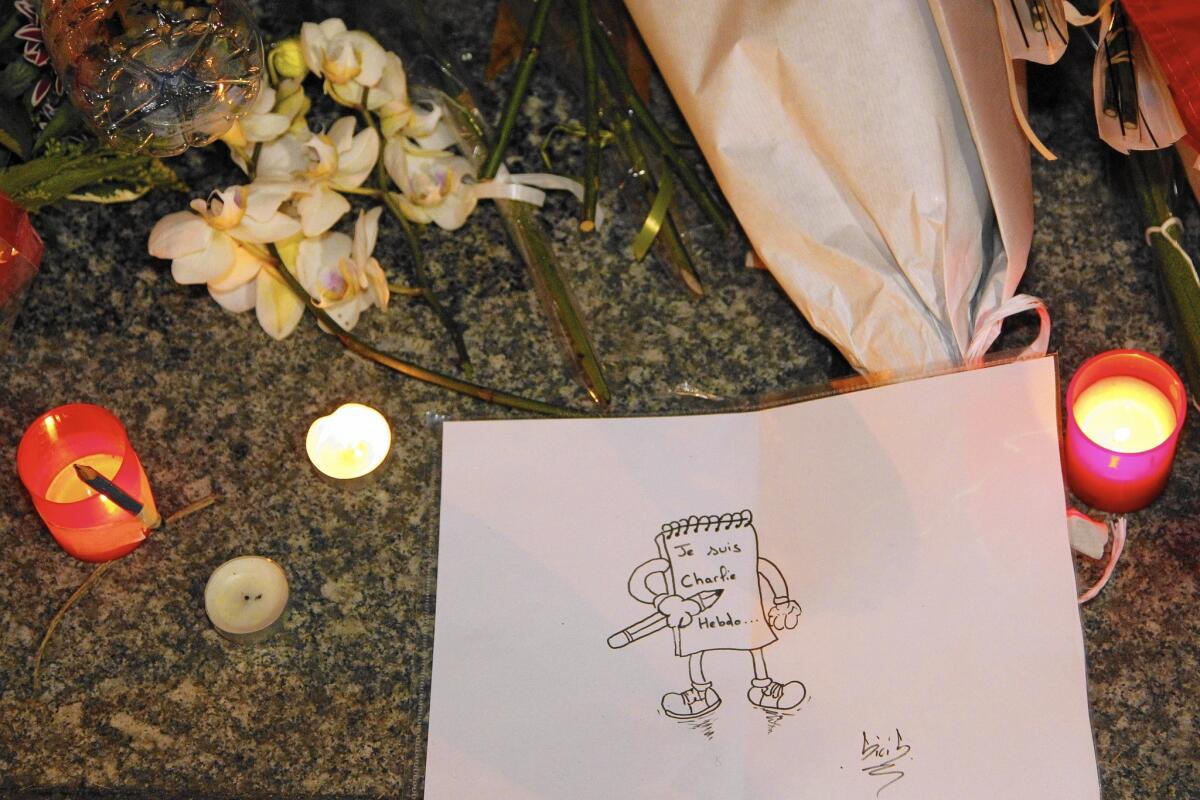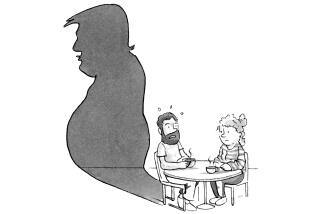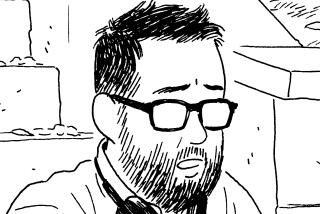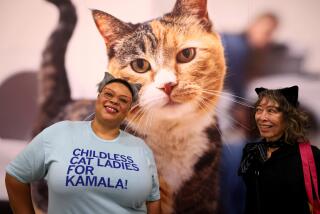Paris attack: Political cartoonists face perils of the pen

- Share via
They are accustomed to poison-pen letters, furious emails, and insults. Now and then, politicians demand they be fired or critics send them excrement. In the tiny fraternity of American political cartoonists, the apoplectic anger their work can elicit speaks to something intrinsic to their craft.
If cartoons are uniquely infuriating, that is because their signature tactics — caricature, ridicule, distortion, hyperbole — do not just flout the ordinary rules of engagement but also jeer at them.
Editorials have the luxury of saying, “On the one hand, on the other hand,” and invite rebuttal. But a cartoon “is not a series of points you can take issue with,” said Kevin Siers, a Charlotte Observer cartoonist who won the 2014 Pulitzer Prize for editorial cartooning. “That’s the point of humor — it bypasses intellectual steps and gets to the heart of things.”
Washington Post cartoonist Ann Telnaes was up early working Wednesday when Twitter came alive with news of the shootings at Charlie Hebdo. Her first reaction was horror. Her second was to start drawing, in memoriam and anger.
Her cartoon in solidarity with the Paris-based satirical magazine and its slain journalists is part of a growing gallery on the poynter.org website, as political cartoonists use the tool at hand — the pen — to stand up for free speech, to reach out and to mourn.
Like “most of my colleagues,” Telnaes said she has received threats because of her work, one serious enough after the Sept. 11 attacks to prompt an FBI investigation. In her view, political cartoons engage and enrage more than articles because they are visual and transcend language barriers.
“A really well-drawn editorial cartoon should grab you quickly,” said Telnaes, who won the Pulitzer Prize for editorial cartooning in 2001. “It’s visual, and it’s satire, mocking people and institutions. Some people don’t expect it. Religious groups are notorious for it. But this is what we do.”
Pat Bagley of the Salt Lake Tribune said the images that “outrage people most are those that spotlight people’s sacred cows.”
He learned this firsthand, he said, long before the so-called Muhammad cartoon crisis of 2005-2006. That’s when hundreds died or were injured during protests in Muslim lands over a dozen cartoons, largely depicting the prophet in an unflattering light, that were published in a Danish newspaper.
A “retired Mormon” in the religion’s capital, Bagley caricatured Mormon prophet Gordon B. Hinckley after he became president of the Church of Jesus Christ of Latter-day Saints.
“There were any number of people willing to be offended on behalf of Hinckley,” Bagley said. “They said it was sacrilegious and I had crossed the line.”
Bagley said he has never had “a direct death threat,” although he has received emails “from people who let me know they own guns, they know how to use them, and I should be careful.”
But he makes a big distinction between threats against editorial cartoonists in the United States and those in other parts of the world.
“One thing that is different is that in Europe and the Middle East, they take cartoons deadly seriously,” said Bagley, who had met several of the slain artists at a cartoonists’ salon around two years ago. “In the U.S., we’re more entertainers, and we don’t get quite the respect or the response they do in Europe or the Middle East.”
Bagley said he couldn’t remember when an American cartoonist had been assaulted or killed for his or her work. “It happens all the time in the Middle East, and it happens way too often in South America and sometimes in Europe. It’s really depressing.”
In the U.S., in important ways, mainstream political cartooning has long been conducted within certain rules of decorum. Cartoons in major publications here rarely approach the deliberate scabrousness of a publication such as Charlie Hebdo, with its seeming delight in provoking offense about taboo subjects such as religion.
It is hard to think of an equivalent publication in America — or an equivalent atmosphere of fear.
David Horsey, a two-time Pulitzer Prize-winning cartoonist who now works for the Los Angeles Times, said that he once received a death threat in response to his work but that nobody had confronted him in person.
People who disagree with him, he said, are often his most loyal followers. “They’re back every day just to tell me what an idiot I am,” he said. “There’s not much hate behind it. It’s, ‘Boy, you’re an idiot,’ not, ‘I’m gonna come get you.’”
On the other hand, he said, editorial cartooning is “a very dangerous job in most parts of the world,” citing examples from Russia to Sri Lanka. “We’re pretty protected because of the nature of our society. In many parts of the world, doing political cartoons about religious groups or about the government lands you in jail or gets you shot or beat up.”
Horsey and others said their first reaction to the news of the massacre was to try to find a way to respond in a cartoon. “It’s the only weapon we have, the only tool we have,” he said. “This can’t go unnoted. So right away, [we think], ‘What’s the image? What can I say?’”
He added, “I think cartoonists all over the world are probably thinking that. ‘These people cannot shut us up.’”
Working editorial cartoonists in the United States make up a small group, with only a few dozen employed by newspapers. The Assn. of American Editorial Cartoonists has about 250 members. It is a specialized craft that relies on an ability to crystallize ideas to their essence, often in a markedly irreverent manner.
“Terrorism really doesn’t strike at physical structures as much as it strikes at ideas, and its main fear is ideas,” said Jack Ohman, the organization’s president and a cartoonist at the Sacramento Bee. “And cartoonists are particularly effective at distilling ideas. I find it fascinating that cartoonists that sign their names to their ideas are murdered in cold blood and terrorists ran away from the scene of their statement anonymously.”
Clay Bennett, Pulitzer Prize-winning political cartoonist at the Chattanooga Times Free Press, thinks he understands why cartoonists elicit more threats than writers do. The writers have “a thousand pebbles to throw every day. A cartoonist has a brick.”
“So when you really hit hard, it really does just pop them right in the nose,” Bennett said. “But it still doesn’t explain why recently we’ve seen so much retaliation. That may be a product of an increased amount of extremism.”
Satire “is the fault line between East and West,” said Kevin Kallaugher, editorial cartoonist for the Economist of London and the Baltimore Sun.
He said he has served as a cultural ambassador in 10 countries through the U.S. Embassy, including Lebanon, Jordan, Azerbaijan. The trips usually entail a week’s visit, an exhibit of his cartoons and lots of conversation.
“One of the things everyone asks me with regards to the whole prophet Muhammad issue is, ‘Why do you hate us so much? Why do you want to do something satirical about our religious leader? The only reason is to denigrate and hurt us,’” he said.
“We have a license in our society to laugh at our heads of state,” he said, but added, “It’s a virtual nanosecond in our time on the planet where we’ve had this notion of freedom of expression.”
To Joel Pett, Pulitzer Prize-winning cartoonist at the Lexington Herald-Leader, the massacre in France serves as a reminder for cartoonists not to squander their opportunity “to draw about something that matters.”
“It’s so tempting to pick the low-hanging fruit — today’s infotainment story or joke about John Boehner crying or something that has absolutely no importance,” said Pett, chair of the board of directors of Cartoonists Rights Network International. “People are dying out there for free speech. Those of us who enjoy it owe it to them to use it in a responsible way.”
Goffard reported from Orange County and LaGanga from Seattle.
More to Read
Sign up for Essential California
The most important California stories and recommendations in your inbox every morning.
You may occasionally receive promotional content from the Los Angeles Times.












